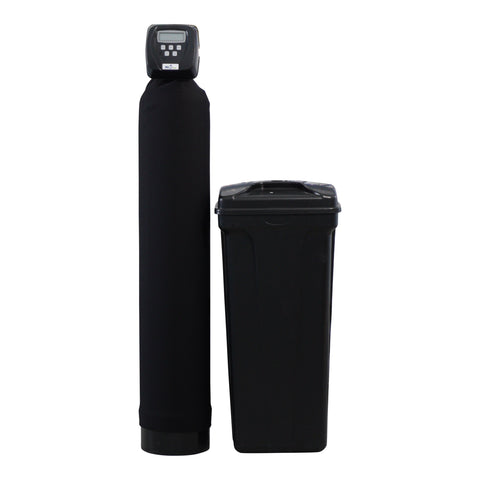
When you have a problem with your water softener, the odds are good that you don’t want to wait or pay for someone to come fix it for you, particularly if you’re at the cottage or you live in a rural area.
The good news is that we can help! One of the most common problems that you’re going to encounter is too much water in your brine tank. While it's normal to have some water in there, if it's more than half full, you’re going to have problems.
How do you fix it? Keep reading to find out.
Water Softener Troubleshooting - Too Much Water in Brine Tank - Any Model
It’s important to know that the tips we’re going to walk through today will work on any model of water softener.
The Most Likely Reason You've Got Too Much Water in the Brine Tank: The Injector is Clogged
If that hole becomes clogged, your unit can't suck the brine out. But it will continue to add more water to the brine tank and that’s a problem.
If this is the case, you just need to replace or clean out that clogged injector. And you’re in luck, we’ve got a great video to show you how to do it. Click here to watch it.
Here are some of the other things you can try.
1. Try a Regen
The first thing we need to know is:
- Does the water level stay at this high level? Or…
- Does the water level drop and then slowly creep up over a period of time?
To figure this out, we need to regenerate the water softener. So, we’re going to find the Regen button on our water softener’s panel. If you want a visual guide, you can watch this video that will walk you through everything.
You will press and hold the Regen button down for 5 seconds so it can go through a regeneration cycle. Once your softener has gone through its complete cycle, check back and see if the water level is still high or if it dropped after the regeneration. If it dropped after the regeneration, check it over the next two or three days and see if that water level is slowly rising up.
2. Check the Brine Line
We’re going to want to check your brine line. That's the 3/8 inch tubing that goes from your brine tank to where the salt is stored to the water softener media tank that has the control valve on top.
Just make sure the connections on both ends are tight. Because if they’re not, when your softener goes through its brine cycle, it won't suck up the brine because there's a vacuum leak or an air leak. It will just keep adding more water, and that water will either leak out or rise up until the float inside the brine tank shuts the water off.
A great way to test this is to put your softener through a regeneration cycle, and then fast forward through the cycles until you get to the fill cycle. At the fill cycle, pay close attention to this connection. If you see water gushing out at this end, that tells you that there's an improper connection.
If you’re not seeing that good connection or you’re seeing a leak, click here to watch a video where we walk you through how to fix it. Basically, you need to remove the C-clip, then ensure the tiny black insert is inside your hose, then slide your tubing in until you meet some resistance, and then push it through that until it won’t go any further. Finally, put the C-clip over top to ensure you have a watertight seal.
You need that good watertight seal to make sure that the brine can go in and out.
3. Check For a Salt Clog in the Brine Tank
The next thing we’re going to do is check for a salt clog at the bottom of the brine tank. This is where you keep your salt.
We always tell our customers to make it a point to run completely out of salt at least once a year, or once every other year, so you can clean up what’s in the bottom. That’s some pretty simple and very helpful maintenance.
If you’ve never run your salt right down to the bottom, it’s possible that the salt has dissolved and has formed into a salt cube/ block at the bottom of your brine tank. If it has created a clog, that’s probably your problem.
If you want to know how to remove that salt clog, watch this video that shows you exactly how to do it.
4. Look for a Clogged Drain Line
When your water softener goes through its regeneration cycle, it shoots water to the drain. As it's going through the brine cycle, there's a slow trickle of water going to the drain. That's what creates the suction to draw the brine out of the brine tank and into the water softener.
If your drain line is clogged, kinked, or frozen, the water softener won't go through that regeneration cycle. It won't suck out the brine, but it will still try to keep adding more water to the brine tank, which would give you that high water level.
You can determine if this is the problem by simply putting it into a regeneration cycle. Normally on a regeneration cycle, the first cycle is backwash (or something like that). You should hear water flowing quickly to the drain. If you hear that water, it’s not the problem. But if you hear absolutely nothing, you may need to unclog, unkink, or thaw the drain line.
5. Check Your Drain Line Flow Control
Next, check your drain line flow control. You can find that attached to your water softener. Simply follow the drain line back to your water softener and then just undo this piece. It's usually elbow-shaped, L-shaped, or something like that.
BUT! Before you do this and disconnect anything, you need to bypass the water softener and start a regeneration cycle to release all the pressure. Then, you can undo the clip and undo the drain line flow control.
If your drain line goes upwards, you're going to have a fair amount of water leaking out because it's going to be draining back down. Make sure you have a bucket or something to drain into.
Your drain line flow control is that little button in the middle of the piece. Simply make sure that it’s not clogged with debris or any small stones that have accumulated.
6. Check Your Brine Well
The next thing we need to check is your brine well, which is inside your brine tank.
Open up the cap and make sure that there's no debris constricting the float from moving. When things are working properly, the float moves freely inside. As the water accumulates, the float will lift up and it shuts off the flow.
But, if the cap from the brine well was left off for a period of time, it’s possible that some salt fell into the brine well (and accumulated at the bottom) while someone was filling it. This is now restricting your float from operating properly. The water can't go in or out, which gives you that high water level. To fix the problem, just remove the brine well and the float, clean it out, and put it all back together.
Once you've got it all back together, make sure that the cap stays on top of the brine well. If you don't have a cap, try to at least make a temporary cap with tape or something like that to prevent this from happening again.
7. Check the Brine Line Flow Control
If you still have a problem, check the brine line flow control.
You will want to follow the brine line that comes from the brine tank and goes up to the water softener’s valve. You will find an L-shaped connection that may have an E-clip holding it in place.
We’re going to remove this and look inside the very small hole to make sure it’s not clogged with any tiny rocks that have accumulated inside.
Once again, we’re going to open it up and clean it out. Now, because this inside is made of rubber, we suggest you don't use something metal to pry the dirt out. A wooden toothpick usually works best. And once you've cleaned that brine line flow control, you also need to clean out your brine tank because there's dirt in there. You don't want to have the same problem again.
Tip to Prevent This From Happening Again: Don't use rock salt. Use pellet-type salt that comes with a cleaner in the pellet.
8. Ensure a Complete Regeneration Cycle Takes Place
Try going through a regeneration cycle just to make sure that it goes through every stage in the proper order.
If there's a problem with your circuit board, it won't know what steps to go through and it won't know what order they should happen in. It may actually skip a step. If this is the case, we would definitely replace that circuit board.
If it's an older model, it may be time for a new water softener.
Remember earlier when we talked about putting the water softener through a cycle and then checking to see if the water level drops after it's gone through a full cycle? If you found that the water level drops after your regen cycle, but slowly creeps back up in the days following that, you've got a leak somewhere in the system.
From here, you have two options:
- Some one-piece water softeners have a couple of pieces that are wedged together to form that valve. If some of the screws are a little bit loose, you might get a slight trickle that keeps adding to the water in the brine tank. And that's when the water level starts going up. So, if you've got a one-piece water softener, you should definitely check for leaks within the components of the valve.
If you have a two-piece, or the solution above doesn’t help your one-piece unit, you may have a problem with the piston that goes inside the valve. The main piston and the brine piston are joined and they fit inside the seal pack. It's a fairly tight fit. But, as they get older, or as they've accumulated debris within the valve itself, water can start leaking past the seal.
If this is the case, we've got a great video that walks you through how to replace that seal pack and the pistons. Click here to watch it. And you can order your new parts by clicking here.
Check out the video here:
Is it Time for a New Water Softener?
If you are in the market for a new water softener solution for your home or cottage, we’re here to help! We recommend something like our HUM Metered Water Softener System 30,000 Grain Capacity, or our AQUAMASTER AMS 700 High-Efficiency Water Softener.
Of course, if you have any questions, you can contact us by clicking here.











